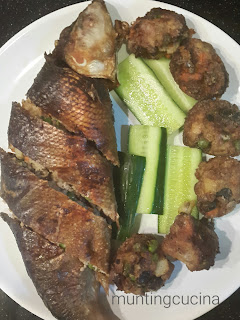Ingredients:
1 tablespoon of unsalted butter to brush the baking sheet
2 cups white granulated sugar
pinch of salt
1/4 corn syrup
1/4 teaspoon baking soda
1/4 corn syrup
1/4 teaspoon baking soda
2 cups unsalted roasted peanuts
1/2 teaspoon oil for wooden spoon
- Use softened butter to brush baking sheet and set aside.
- In a medium saucepan combine sugar, water, corn syrup and salt, let boil over high heat.
- Swirl until sugar dissolves, (do not stir) until light golden brown or until it reaches soft crack stage if using a candy thermometer.
- Add baking soda, stir then add the peanuts, mix quickly to coat the peanuts.
- Transfer to the greased baking sheet. Flatten peanuts and let cool.
- Crack the peanut brittle before it dries up completely.
- Enjoy your peanut brittle.
Health Benefits
- Peanuts are rich in energy (567 calories per 100 g) and contain health benefiting nutrients, minerals, antioxidants and vitamins that are essential for optimum health.
- They compose sufficient levels of mono-unsaturated fatty acids (MUFA), especially oleic acid. MUFA helps lower LDL or "bad cholesterol" and increaseS HDL or "good cholesterol” level in the blood. Research studies suggest that Mediterranean diet which is rich in monounsaturated fatty acids help to prevent coronary artery disease and stroke risk by favoring healthy blood lipid profile.
- Peanut kernels are a good source of dietary protein; compose fine quality amino acids that are essential for growth and development.
- Research studies have shown that peanuts contain high concentrations of poly-phenolic antioxidants, primarily p-coumaric acid. This compound has been thought to reduce the risk of stomach cancer by limiting the formation of carcinogenic nitrosamines in the stomach.
- Peanuts are an excellent source of resveratrol, another polyphenolic antioxidant. Resveratrol has been found to have a protective function against cancers, heart disease, degenerative nerve disease, Alzheimer's disease, and viral/fungal infections.
- Furthermore, studies suggest that resveratrol may reduce stroke risk through altering molecular mechanisms in the blood vessels (reducing susceptibility to vascular damage through decreased activity of angiotensin, a systemic hormone responsible for blood vessel constriction that would elevate blood pressure), and by increasing production of vasodilator hormone, nitric oxide.
- Recent research studies suggest that roasting/boiling enhances antioxidant bio-availability in the peanuts. It has been found that boiled peanuts have two and four-fold increase in isoflavone antioxidants biochanin-A and genistein content, respectively. (Journal of agricultural and food chemistry).
- The kernels are an excellent source of vitamin E (a-tocopherol); containing about 8 g per100 g. vitamin E is a powerful lipid soluble antioxidant which helps maintain the integrity of cell membrane of mucus membranes and skin by protecting from harmful oxygen free radicals.
- The nuts are packed with many important B-complex groups of vitamins such as riboflavin, niacin, thiamin, pantothenic acid, vitamin B-6, and folates. 100 g of peanuts provide about 85% of RDI of niacin, which contributes to brain health and blood flow to the brain.
- The nuts are a rich source of minerals like copper, manganese, potassium, calcium, iron, magnesium, zinc, and selenium. http://www.nutrition-and-you.com


















